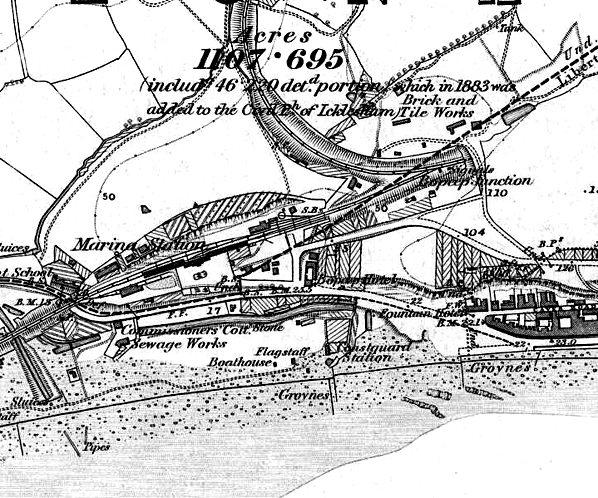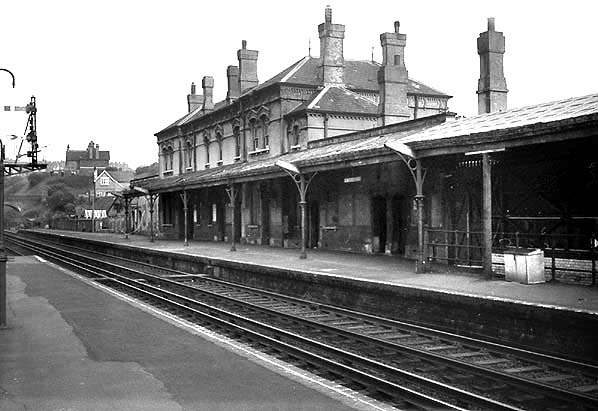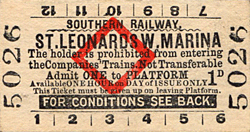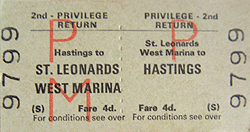
Station Name: ST. LEONARDS WEST MARINA[Source:
Nick Catford]
old3.jpg) LB&SCR petrol-electric railcar No.3 trundles through St Leonards West Marina when brand new. The LB&SCR had four of these contraptions of which two, Nos.3, 4 and possibly a third came new. Sources dither between 1904 and 1905 for delivery dates for Nos.3 and 4 but as their numbers are assumed to be in sequence with steam railmotors Nos.1 and 2 the date would have been 1905. The petrol cars were built by Dick, Kerr & Co. (usually referred to simply as 'Dick Kerr') and presumably at their Preston works. They were 4-wheelers with rather attractive underframes, the side plates of which swept downwards to accommodate the horn guides. Suspension was by rather enormous leaf springs, one of which can seen in this view. The petrol engine is believed to have been of Daimler manufacture; this drove a dynamo to provide power for a single traction motor driving one axle. Dick Kerr was one of the big players of the time (they eventually became part of English Electric) and were involved with a number of electric traction schemes but are perhaps best known for tramcars. Bearing this in mind the LB&SCR railcars would have had some equipment common to tramcars including traction motors and controllers. Be this the case, the traction motors would have been in the region of 40 - 50hp. All traction equipment, including the engine, was beneath the floor on a subframe assembly slung from the underframe. As built, No.3 had largely open driving cabs, as seen in this view, but the driver was afforded the luxury of a windscreen. This arrangement apparently proved most unsatisfactory and full width windscreens were fitted very soon after delivery and hence we know No.3 was brand new when photographed. All these Dick Kerr railcars had bodywork resembling contemporary single-deck tramcars but No.3 was unique in that it had two 5-bay saloons each side of a central doorway and as such was more resembling of an early American streetcar. No.3 also had a clerestory roof, unusual in that extended almost the full width of the body. As with the bays, this feature also appears to be have been unique to No.3. The headcode disc has proved impossible to identify as no crossed disc, on its own and in the position shown, has been traced applying to the Hastings - Lewes/Eastbourne/Brighton line. There appears to be a crush of people in the leading 'cab' which would suggest the railcar was on trial or on a driving training run, in which case it would almost certainly be running to and from Brighton. Railcar No.4 was identical insofar as its mechanical and electrical aspects were concerned but it had a much improved body. It retained the central doorway but had a 2½ bay saloon either side. It also lacked the somewhat ungainly clerestory and appears to have had full width windscreens from new. Services operated are unclear. They would have been trialled on a number of routes but are likely to have worked Brighton/Eastbourne - Hastings shuttles, as steam railmotors are known to have done. They are believed to have also operated on the Kemp Town branch and it is highly likely, albeit unconfirmed, that a trial was also undertaken on The Dyke branch. So what of the other two LB&SCR Dick Kerr railcars? The Great Northern Railway (GNR) also ordered two, to be their Nos.3 and 4. GNR No.3 was broadly similar to LB&SCR No.4 but lacked the centre doorway. Instead it had wider doors at each end from which was accessed the driving cabs and passenger saloons. It further differed to the LB&SCR cars in having doorways at both ends and on both sides although presumably two diagonally opposite doorways would have been only for drivers use. GNR No.4 was similar to GNR No.3 but had eight bays (No.3 had five). No.4 is otherwise something of a mystery as it was apparently never delivered to the GNR. Nothing more was heard of it until 1908/9 when it turned up on the LB&SCR together with GNR No.3. The reason appears to have been cancellation by the GNR and the order eventually diverted to the LB&SCR, see below. The pair were given full LB&SCR livery but with the additional 'Electrical Department' branding. Joined by the two original LB&SCR cars, all four were modified for use with the Electrical Department as maintenance/inspection cars for the LB&SCRs South London overhead electrification scheme which commenced operation in 1909. The company referred to the scheme as 'Elevated Electric' and this should not be confused with elevated railways. Modifications were as might be expected; a walkway accessed by steps from the interior was fitted to the roofs; floodlights were installed on each cab roof; battery boxes were fitted midway along the outside of the underframes for powering the floodlights. It is not, however, known if the batteries could be charged from the railcars own dynamos or if a shore supply was required. If the railcars dynamos were used then a complex, for the time, circuit would have been required so in all likelihood a shore supply was used. As the railcars were now in departmental use they underwent renumbering. What had been LB&SCR No.3 became departmental No.4, while the never-to-be GNR No.4 became departmental No.1. The mystery surrounding this car seems to have been cancellation of the order by the GNR, with it eventually being diverted to the LB&SCR but in the form of an overhead maintenance car - the conversion being undertaken by Dick Kerr prior to delivery to Brighton. This would explain why some sources state departmental No.1 was 'purpose built' and given its number it may well have been the prototype for conversion of the other three. The remaining two railcars became departmental Nos.2 and 3 but in what order is not known. A photograph exists of ex-GNR No.3 in use and complete with tower on its roof at Peckham Rye but its new number is illegible. Two, at least, of the railcars are known to have still been in use in 1927, still in LB&SCR livery, and probably remained in use until 1929 when the Southern Railway abandoned the 'Elevated Electric' in favour of the third rail system. The railcars short life in passenger service (three or four years at best) should not be taken as a sign their petrol-elecrtic equipment was a failure. Their downfall was probably as with most small, 4-wheel passenger railway vehicles; inflexible; limited luggage capacity, inability to haul trailers and in all probability rough riding on the jointed track of the time.
 
1878 6" map. The station is shown as 'Marina', a name it never officially had. West St. Leonards station hadn't been built at this time. It opened 1 October 1887.

1880 1:2,500 OS map shows the4 original layout of St. Leonards West Marina station and the adjacent 2-road engine shed. This map shows the original position of the station. Click here for a larger version.

1909 1:2,500 OS map shows the station has been resited a short distance to the east. There is now a much enlarged goods yard to the south of the station. The original goods shed appears to have been retained but numerous new sidings have been added, together with a goods store, cattle dock and a 1 10-ton capacity crane. The original engine shed has been replaced with a 4-road shed and a larger turntable has been provided. There has also been considerable residential development on both sides of the line. The original station building was where the cattle dock is shown. Click here for a larger version.
old2.jpg) St. Leonards West Marina station from the air in February 1920. The engine shed with its north light roof is seen to the rear of the station.
Reproduced with the kind permission of Simmons Aerofilms Ltd.  Looking west from St. Vincent's Road bridge towards St. Leonard's West Marina station and depot in September 1931. A locomotive is seen on the turntable.
Copyright photo from John Alsop collection old6.jpg)
An eastbound train waits in the down platform of St. Leonards West Marina station c1934.2374 is a Billington designed 0-4-4T D-3 built for the London Brighton & South Coast Railway at Brighton works in December 1892. This class of loco were built for working passenger trains along country and main lines. It originally had the number 374. It just survived into BR ownership. After being renumbered 32374 it was withdrawn from Tonbridge shed in January 1949 and cut up later that year.
Photo from John Mann collection 
With West Marina station on the right, the camera captures a full house at St Leonards Motive Power Depot. Third rail electrification was installed in 1935 from Brighton but it ends at Ore, just east of Hastings, with diesel services beyond to what is now Ashford International. The typical diesel service operates to and from Brighton with the Brighton - Ore section shared with electric trains. The photograph is undated but an approximate year is easy to determine. Most, if not all, the locomotives appear to be in wartime black livery while on the station a large number of canopy support columns and at least two lamp standards are painted black and white as part of the wartime blackout contingency. The shed is in its pre-1949 form, the year it was altered by British Railways. Unlikely, although not impossible, to have been taken during the war and given none of the locomotives appear to be carrying any form of British Railways identity we can safely date the photograph to 1945 - September 1948. The reason for the latter date will shortly become clear. Not all the locomotives can be identified with any certainty but of those which can there are a number of 0-6-0 tender types of Classes C and O1, plus a couple of Class U1 2-6-0s; one on No.3 road and another just inside the shed on No.2 road. Also on No.2 road and nearest the camera is an ex SE&CR Wainwright 'Coppernob' Class D 4-4-0. Of these, only two can be positively identified by number; one of the 'U-Boats' and the 'Coppernob'. The former is No.902; she spent much of her life, unsurprisingly, on the former L&SWR section but did have spells on the Central Section. She became BR No.31902 in September 1948 and survived until November 1962. The 'Coppernob' is No.1740; she was built at Ashford in 1901 and was a St. Leonards locomotive at this time. She was allocated BR No.31740 but withdrawn in March 1951 without receiving her new number.
Photo received from Ian Mantel old7.jpg) St. Leonards West Marina station looking east in 1950 as a loco runs light through the up platform. The large triangular cattle dock is seen behind the platform; it was served by three sidings, one either side and one end on to the dock.
Photo from John Mann collection old9.jpg)
St. Leonard's West Marina station station forecourt c1957.
Photo from John Mann collection wm16.jpg) Southern Railway 'target' signs were still in use at the station until closure in 1967.
Photo received from Leon V.J.Coast 
St. Leonard's West Marina station in autumn 1968, a year after closure; little has changed
Photo by Nick Catford  St. Leonards West Marina station looking east in autumn 1968, the motive power depot St. Leonards West Marina station looking east in autumn 1968, the motive power depotcan be seen to the left. Photo by Nick Catford wm15.jpg)
St. Leonard's West Marina station looking west from the degraded up platform in May 1977. The depot closed in the 1970s and was quickly demolished and replaced with a train washing facility.
Photo by Nigel Mundy 4.jpg)
St. Leonard's West Marina station looking east in November 1982. The main station building was to the right of the fence. Note the red signs on the down platform telling passengers 'do not alight here'. The platform was retained for railway staff.
Photo by Nick Catford 
St. Leonard's West Marina station looking west from St. Vincent's Road bridge in October 2007 - taken from a similar viewpoint to the 1931 picture above.
Photo by Chris Fletcher  The eastbound platform at St. Leonards West Marina station looking east in October 2007
Photo by Chris Fletcher
 Home Page Home Page
|
 Notes: St Leonards West Marina station was opened by the Brighton, Lewes and Hastings Railway in 1846 as part of what became the East Coastway Line, it was the first permanent station to serve the area and became part of a feud between two rival railway companies over access to nearby Hastings. Although ultimately inconvenient for local services, the station became an important goods railhead and the location of a motive power depot for locomotives working express services to London. The station was closed in 1967 following dieselisation of the London-Hastings line and subsequently demolished, although in 2011 remnants of the down platform could still be seen.
Notes: St Leonards West Marina station was opened by the Brighton, Lewes and Hastings Railway in 1846 as part of what became the East Coastway Line, it was the first permanent station to serve the area and became part of a feud between two rival railway companies over access to nearby Hastings. Although ultimately inconvenient for local services, the station became an important goods railhead and the location of a motive power depot for locomotives working express services to London. The station was closed in 1967 following dieselisation of the London-Hastings line and subsequently demolished, although in 2011 remnants of the down platform could still be seen. The BL&H had powers to extend the line to a junction with the South Eastern Railway (SER) at Ashford, thereby creating a coastal route from Brighton to Dover of strategic military importance to the government.The SER took advantage of the government's desire for the line by offering to construct the section between Hastings and Ashford in return for powers to build the North Kent Line, which resulted in the government agreeing to authorise the Hastings-Ashford line provided the SER extended its Tonbridge-Tunbridge Wells line to Hastings. In view of the low revenue earning potential of a Hastings-Ashford line with Rye the largest settlement to be served, the BL&H agreed to transfer ownership of the section to the SER whilst retaining the right to exercise running powers as far as Hastings.
The BL&H had powers to extend the line to a junction with the South Eastern Railway (SER) at Ashford, thereby creating a coastal route from Brighton to Dover of strategic military importance to the government.The SER took advantage of the government's desire for the line by offering to construct the section between Hastings and Ashford in return for powers to build the North Kent Line, which resulted in the government agreeing to authorise the Hastings-Ashford line provided the SER extended its Tonbridge-Tunbridge Wells line to Hastings. In view of the low revenue earning potential of a Hastings-Ashford line with Rye the largest settlement to be served, the BL&H agreed to transfer ownership of the section to the SER whilst retaining the right to exercise running powers as far as Hastings. The BL&H had been taken over by the London, Brighton and South Coast Railway (LB&SCR) on 27 July 1846. They decided to exercise the right to run as far as Hastings. This would give it a route from London Bridge to St Leonards of 76.5 miles, somewhat shorter than the SER's circuit of 93 miles travelling via Redhill and Tonbridge and then Ashford. A crisis was therefore triggered when the SER's line to Hastings and the short stretch from St Leonards opened simultaneously on 13 February 1851.The SER made it difficult for LB&SCR services to use the new line by holding up a train for so long at Bo-peep junction that it was obliged to return to St Leonards and unload its passengers. Later, the SER tore up track at Bo-Peep and obstructed the line with wagons filled with earth.
The BL&H had been taken over by the London, Brighton and South Coast Railway (LB&SCR) on 27 July 1846. They decided to exercise the right to run as far as Hastings. This would give it a route from London Bridge to St Leonards of 76.5 miles, somewhat shorter than the SER's circuit of 93 miles travelling via Redhill and Tonbridge and then Ashford. A crisis was therefore triggered when the SER's line to Hastings and the short stretch from St Leonards opened simultaneously on 13 February 1851.The SER made it difficult for LB&SCR services to use the new line by holding up a train for so long at Bo-peep junction that it was obliged to return to St Leonards and unload its passengers. Later, the SER tore up track at Bo-Peep and obstructed the line with wagons filled with earth. An injunction obtained by the LB&SCR ensured the reopening of the line and the two companies began to share traffic receipts, culminating in an agreement in 1866 by which St Leonards Warrior Square, the SER's intermediate station between Hastings and the LB&SCR's St Leonards station, became a joint station and facilities were provided here and at Hastings to allow joint SER/LB&SCR operation of the line. LB&SCR services were nevertheless not allowed to call at Warrior Square until December 1870, at which point the LB&SCR changed the name of its own St Leonards station to St Leonards West Marina.
An injunction obtained by the LB&SCR ensured the reopening of the line and the two companies began to share traffic receipts, culminating in an agreement in 1866 by which St Leonards Warrior Square, the SER's intermediate station between Hastings and the LB&SCR's St Leonards station, became a joint station and facilities were provided here and at Hastings to allow joint SER/LB&SCR operation of the line. LB&SCR services were nevertheless not allowed to call at Warrior Square until December 1870, at which point the LB&SCR changed the name of its own St Leonards station to St Leonards West Marina. The station's status fell after the 1921 grouping, although it retained a certain importance until the late 1950s as a locomotive depot. Following electrification of the East Coastway line in 1935 by the Southern Railway, the service pattern introduced from May saw express trains from London Victoria call at all stations except West Marina. Nevertheless, the station became the terminus for London services in November 1949 when it was necessary to close Bopeep Tunnel for repairs; buses ferried passengers from West Marina to St Leonards Warrior Square. Normal services through the tunnel resumed on 5 June 1950. Remarkably the now dilapidated station remained open to passengers until 10 July 1967; the station's goods yard already having closed on 26 November 1962.
The station's status fell after the 1921 grouping, although it retained a certain importance until the late 1950s as a locomotive depot. Following electrification of the East Coastway line in 1935 by the Southern Railway, the service pattern introduced from May saw express trains from London Victoria call at all stations except West Marina. Nevertheless, the station became the terminus for London services in November 1949 when it was necessary to close Bopeep Tunnel for repairs; buses ferried passengers from West Marina to St Leonards Warrior Square. Normal services through the tunnel resumed on 5 June 1950. Remarkably the now dilapidated station remained open to passengers until 10 July 1967; the station's goods yard already having closed on 26 November 1962. A motive power depot was established at the station by the LB&SCR in 1846 on the down side of the line to the west of the Bo-Peep tunnel. The depot served the Hastings area and was a small two-road shed, constructed in brick with a turntable on the northern side.This was replaced by a second larger 4-road shed in 1872, which was enlarged in 1898 and again by British Railways in 1949. In 1926, the shed had 62 staff including 20 drivers and firemen. Following the demolition of the ex-SER shed at Hastings, West Marina shed grew in importance as it took over the former shed's entire allocation in 1929. A new wheel drop facility was fitted in the same year to assist with the increased workload, as were additional carriage sidings. The first of 12 SR V Schools class locomotives arrived in 1931, adding to the shed's 20-odd 4-4-0s, F1s, Ls and a handful of tank and 0-6-0s. The Schools class were used to work Hastings Line expresses to London. As of January 1947, its allocation consisted of 30 locomotives: 20 4-4-0s, 5 0-4-4Ts and 5 0-6-0s.
A motive power depot was established at the station by the LB&SCR in 1846 on the down side of the line to the west of the Bo-Peep tunnel. The depot served the Hastings area and was a small two-road shed, constructed in brick with a turntable on the northern side.This was replaced by a second larger 4-road shed in 1872, which was enlarged in 1898 and again by British Railways in 1949. In 1926, the shed had 62 staff including 20 drivers and firemen. Following the demolition of the ex-SER shed at Hastings, West Marina shed grew in importance as it took over the former shed's entire allocation in 1929. A new wheel drop facility was fitted in the same year to assist with the increased workload, as were additional carriage sidings. The first of 12 SR V Schools class locomotives arrived in 1931, adding to the shed's 20-odd 4-4-0s, F1s, Ls and a handful of tank and 0-6-0s. The Schools class were used to work Hastings Line expresses to London. As of January 1947, its allocation consisted of 30 locomotives: 20 4-4-0s, 5 0-4-4Ts and 5 0-6-0s. Following nationalisation, the shed was given the code 74E and it received a new asbestos roof with brick gables. However, by 1957 the depot's role was much reduced as a result of the first stages of dieselisation which had led to the closure of the servicing point at Hastings station and the withdrawal of most of St Leonards' engines. Further dieselisation resulted in the depot's effective closure in June 1958, although engines continued to be serviced and stabled until 10 November 1967. The bulk of the shed's remaining allocation was transferred to Ashford, Brighton, Tonbridge and Tunbridge Wells West. The depot remained open into the 1970s but had been completely demolished by 1976. An train washing facility now standing on the site.
Following nationalisation, the shed was given the code 74E and it received a new asbestos roof with brick gables. However, by 1957 the depot's role was much reduced as a result of the first stages of dieselisation which had led to the closure of the servicing point at Hastings station and the withdrawal of most of St Leonards' engines. Further dieselisation resulted in the depot's effective closure in June 1958, although engines continued to be serviced and stabled until 10 November 1967. The bulk of the shed's remaining allocation was transferred to Ashford, Brighton, Tonbridge and Tunbridge Wells West. The depot remained open into the 1970s but had been completely demolished by 1976. An train washing facility now standing on the site. 


old_thumb8.jpg)







